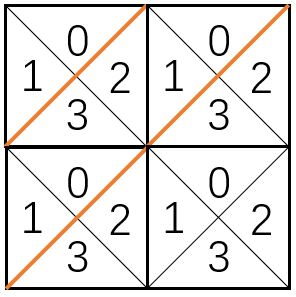Share
In a N x N grid composed of 1 x 1 squares, each 1 x 1 square consists of a /, , or blank space. These characters divide the square into contiguous regions.
(Note that backslash characters are escaped, so a \ is represented as “\”.)
Return the number of regions.
Example 1:
Input:
[
" /",
"/ "
]
Output: 2
Explanation: The 2x2 grid is as follows:
Example 2:
Input:
[
" /",
" "
]
Output: 1
Explanation: The 2x2 grid is as follows:
Example 3:
Input:
[
“\/”,
“/\”
]
Output: 4
Explanation: (Recall that because \ characters are escaped, “\/” refers to /, and “/\” refers to /.)
The 2x2 grid is as follows:
Example 4:
Input:
[
“/\”,
“\/”
]
Output: 5
Explanation: (Recall that because \ characters are escaped, “/\” refers to /, and “\/” refers to /.)
The 2x2 grid is as follows:
Example 5:
Input:
[
“//”,
"/ "
]
Output: 3
Explanation: The 2x2 grid is as follows:
Note:
1 <= grid.length == grid[0].length <= 30
grid[i][j] is either ‘/’, ‘’, or ’ ’
题解:
我没有用深度优先搜索的方法,我是使用并查集来做的,对于每一个小方块,我将它划分为4个区域,以2*2的网格为例

黄色的线是代表连接上了,对于grid的每一个值的取值范围为’’,’/’,’ ‘,当这个值为’/‘或者’ ‘时,我们就将0和1连接起来,2和3连接起来,如果是’‘或者’ '时,就将0和2连接起来,1和3连接起来,处理完这个小方格之后,还要让这个小方格和其它小方格连接起来,最后只需要统计有多少个树根即可
下面贴代码:
class DSU:
def init(self, N):
self.p = range(N)
def find(self, x):
if self.p[x] != x:
self.p[x] = self.find(self.p[x])
return self.p[x]
def union(self, x, y):
xr = self.find(x)
yr = self.find(y)
self.p[xr] = yr
class Solution(object):
def regionsBySlashes(self, grid):
N = len(grid)
dsu = DSU(4 * N * N)
for r, row in enumerate(grid):
for c, val in enumerate(row):
root = 4 * (r*N + c)
if val in '/ ':
dsu.union(root + 0, root + 1)
dsu.union(root + 2, root + 3)
if val in '\ ':
dsu.union(root + 0, root + 2)
dsu.union(root + 1, root + 3)
# north/south
if r+1 < N: dsu.union(root + 3, (root+4*N) + 0)
if r-1 >= 0: dsu.union(root + 0, (root-4*N) + 3)
# east/west
if c+1 < N: dsu.union(root + 2, (root+4) + 1)
if c-1 >= 0: dsu.union(root + 1, (root-4) + 2)
return sum(dsu.find(x) == x for x in xrange(4*N*N))





















 8万+
8万+

 被折叠的 条评论
为什么被折叠?
被折叠的 条评论
为什么被折叠?








